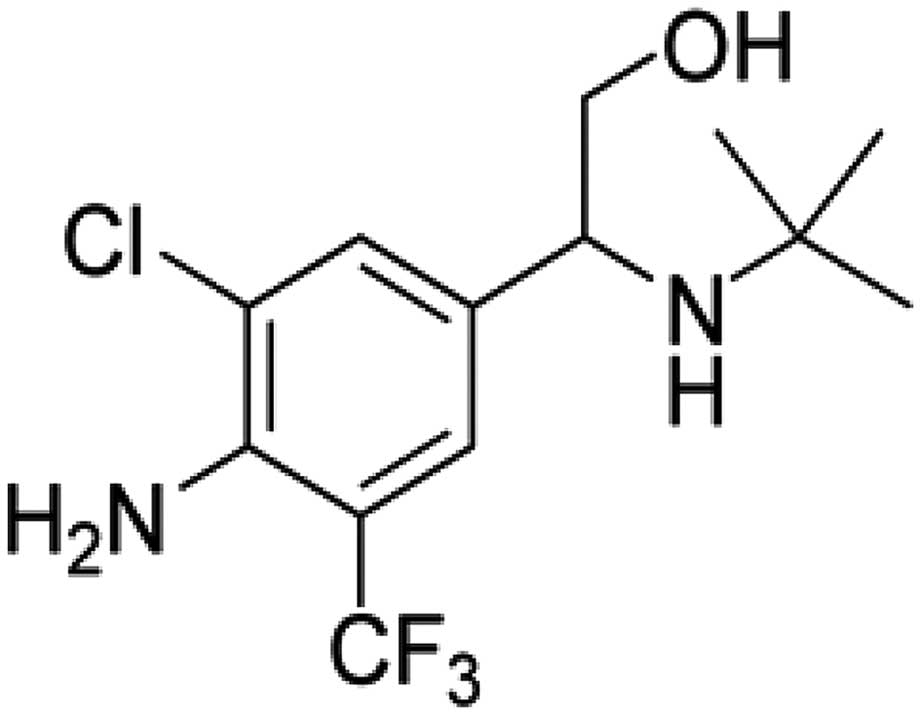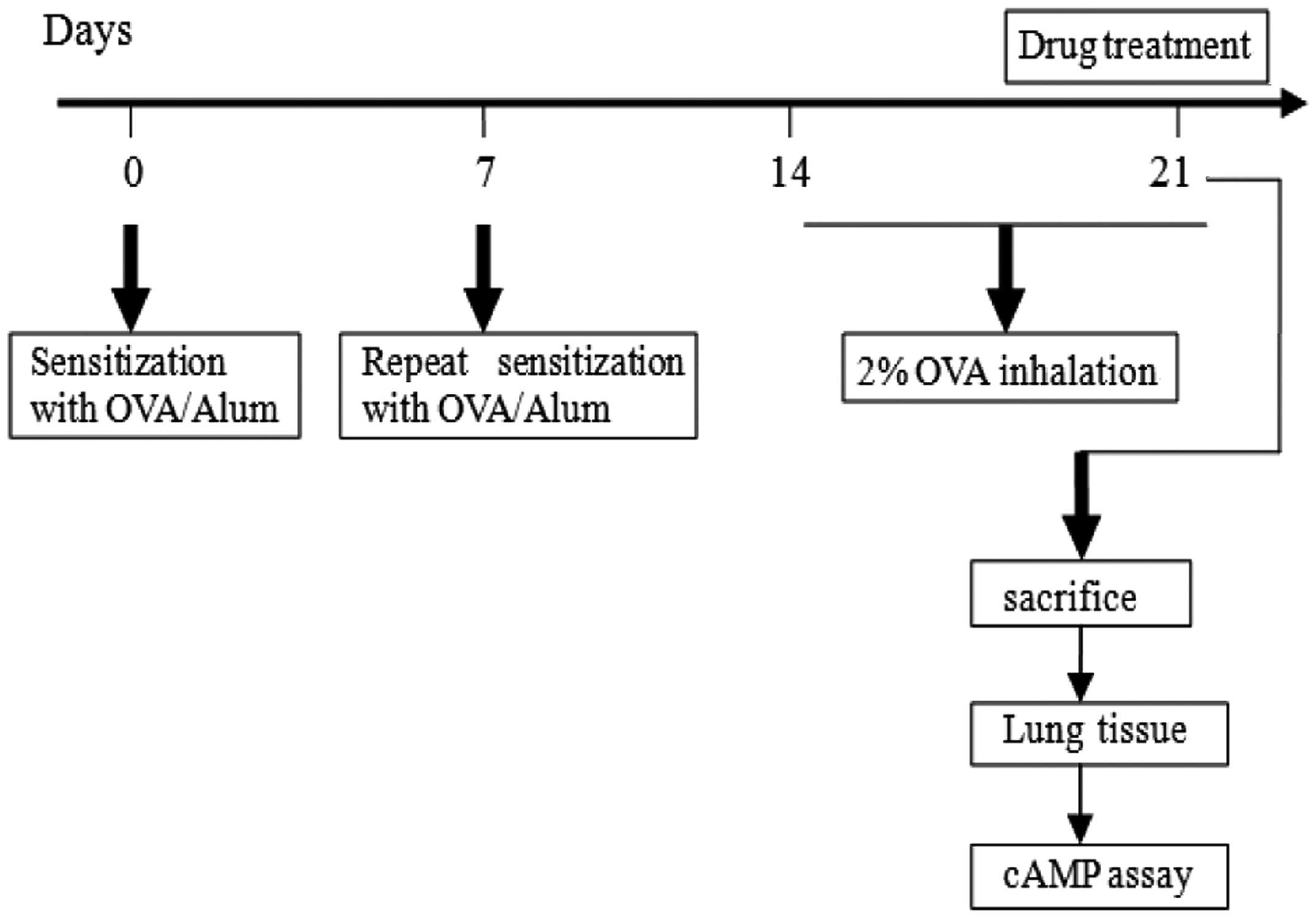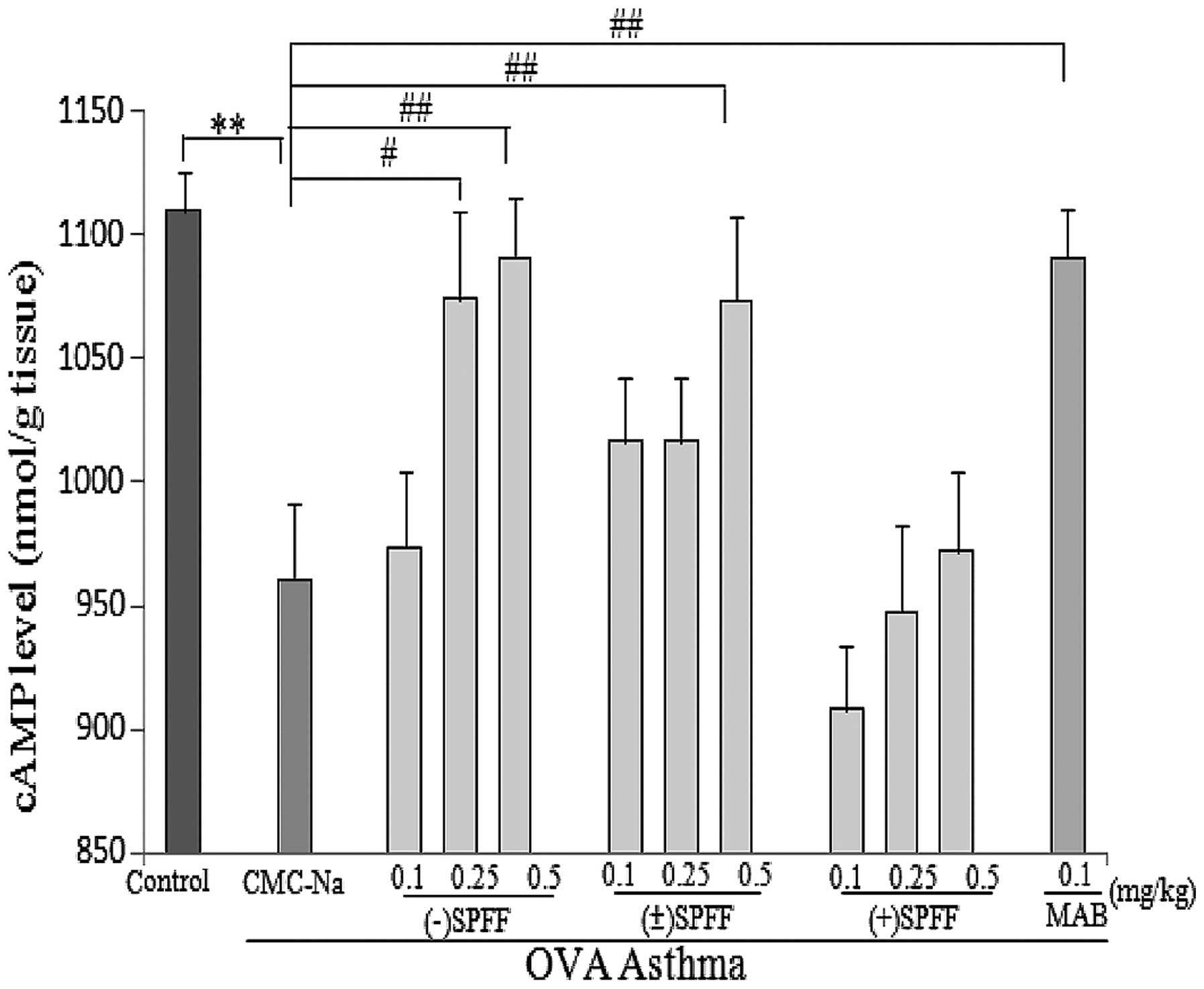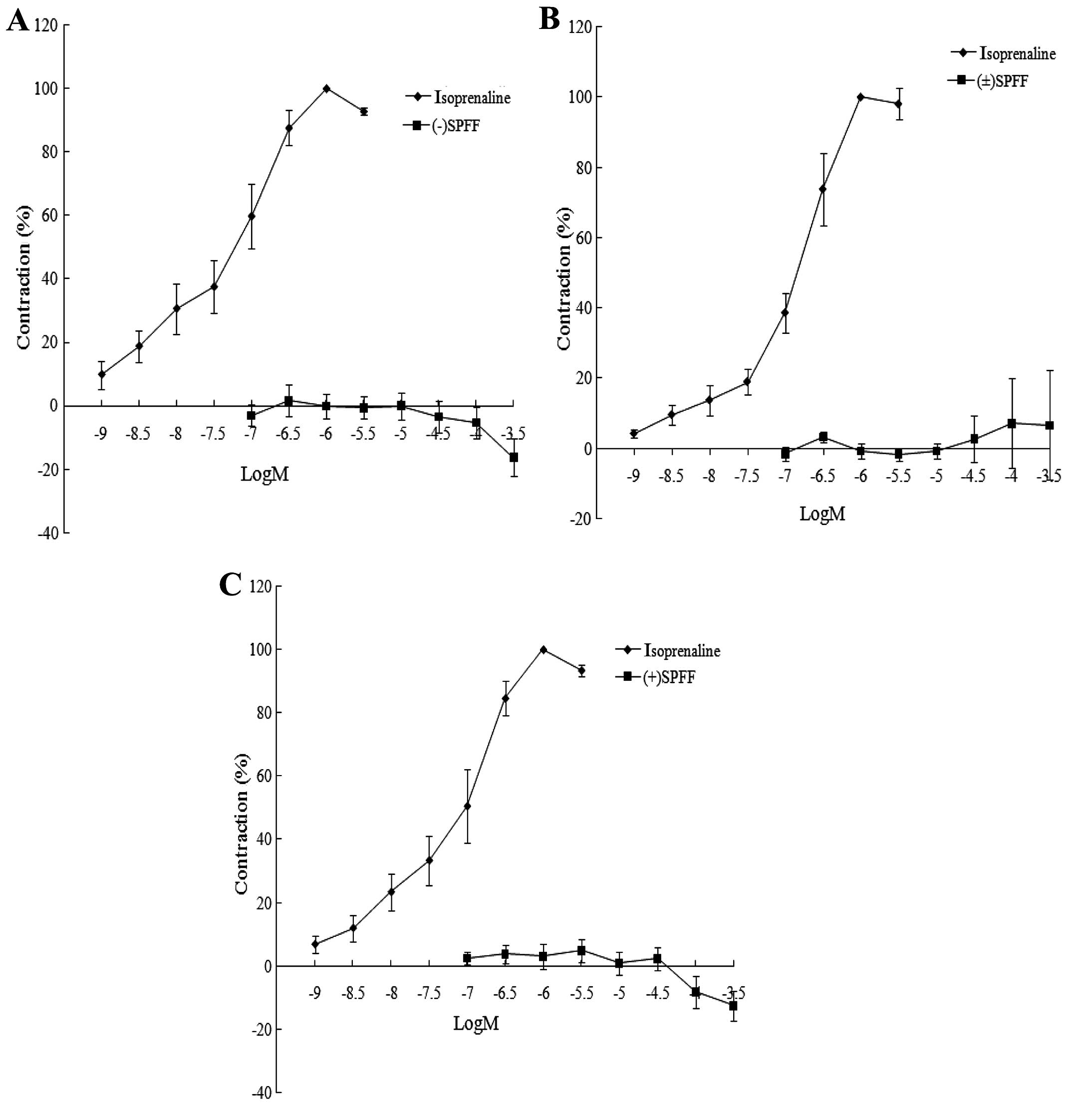Stereoselective activity of 2?(4?amino?3?chloro?5?tri?uomethyl?phenyl)?2?tert?butylamino?ethanol hydrochloride to improve the pulmonary function in asthma
- Authors:
- Published online on: May 19, 2014 https://doi.org/10.3892/br.2014.279
- Pages: 539-544
Abstract
Introduction
Asthma is a chronic airway disease that is characterized by significantly exacerbated bronchospasms and marked inflammation of the airways. Episodic airway obstruction and airway inflammation are two features of bronchial asthma (1). While the exact etiology of asthma remains unknown, it is involved in possible genetic predispositions coupled with an exposure to ‘inflammatory triggers’ and ‘bronchospastic triggers’ (2). Based on clinical manifestations, the principles of pharmacotherapy are mainly centered on the reversal or prevention of bronchial smooth muscle constriction and the reversal or prevention of airway inflammation following asthmatic seizures. β-adrenergic receptor agonists are key drugs in the management of asthma as they relax the bronchial smooth muscles (3). Previously, a highly-selective β2-agonist with a high liposolubility, active over a longer period of time and with fewer adverse reactions was identified, and is a potential option for the treatment of bronchial asthma (4).
2-(4-Amino-3-chloro-5-trifluomethyl-phenyl)-2-tert-butyl- amino-ethanol hydrochloride (SPFF) is a novel compound derived from the traditional β2-agonist that, to the best of our knowledge, was first developed by the Shenyang Pharmaceutical University (Shenyang, Liaoning, China) (5). It is a racemic mixture of equal amounts of (−)SPFF and (+)SPFF due to the chiral carbon atom in its chemical structure. Previously, it was shown that SPFF was able to relax isolated tracheal smooth muscles (5). The aim of the present study was therefore to compare and contrast the relaxant effect on the airways in vivo and the inhibition on allergy mediator release by the various isomers of SPFF. The findings of this study may also provide a theoretical and experimental basis for further development of novel drugs for asthmatic pulmonary function.
Materials and methods
Chemicals and drugs
(−)SPFF, (±)SPFF, (+)SPFF and mabuterol (MAB) were supplied by the Pharmaceutical Engineering Department, Shenyang Pharmaceutical University (enantiomeric excess, >99%). The chemical structure of SPFF is shown in Fig. 1. Isoprenaline chloride was purchased from Shanghai Harvest Pharmaceutical Co., Ltd (Shanghai, China). Pentobarbital sodium and histamine phosphate were purchased from Sinopharm Chemical Reagent Co., Ltd. (Shanghai, China). Propranolol hydrochloride was obtained from the Northeast Pharmaceutical Group Co., Ltd. (Shenhe, Shenyang, China), ovalbumin (OVA) was provided by Sigma-Aldrich (Hong Kong, China) and the adsorbed diphtheria, tetanus and acellular pertussis combined vaccine were provided by the Chengdu Institute of Biological Products (Chengdu, Sichuan, China).
Animals
Dunkin-Hartley male guinea pigs, weighing 300±50 g, and Wistar male rats, weighing 150±30 g, were provided by the Experimental Animal Centre, Shenyang Pharmaceutical University. Animals were housed in a room at a temperature of 21–23°C, a relative humidity of 30–70% and a 12-h light/dark cycle with free access to food and water. All experimental procedures carried out in the study were performed in accordance with the Guidelines for the Care and Use of Laboratory Animals of Shenyang Pharmaceutical University.
Konzett and Rössler experiment in anesthetized guinea pigs
The animals were randomly divided into 11 groups (n=6 per group) and anesthetized with pentobarbital [30 mg/kg, intraperitoneal injection (i.p.)]. Body temperature was maintained at 36–37°C with a heating pad and the Konzett and Rössler experiment was performed with slight modifications to an established method (6). Briefly, the trachea was cannulated and ventilated 60 times/min with a tidal air volume of 8 ml/kg using a respirator. The histamine-induced bronchoconstriction was measured using a flow transducer and recorded by a biosignal recording system. Histamine (20 μg/kg) was administered intravenously 30, 60, 90, 120, 150, 180, 210 and 240 min after the intraduodenal administration of the test drugs. Histamine-induced bronchoconstriction prior to the administration of normal saline (N.S.) or the tested drugs was established as 100% and the inhibition rate of each bronchodilator was calculated at various time points.
Effect on allergic mediator (histamine) release following an allergen challenge in rats
Wistar rats (n=24) were sensitized by i.p. of 0.5 ml 10% OVA emulsified in 10 mg aluminum hydroxide gel in a total volume of 100 μl in N.S., according to the method described by Kucharewicz et al (7) with slight modifications. Two weeks later, the animals were sacrificed by cervical dislocation and the lung tissues were removed and divided into small samples. The tissues were incubated for 5 min in 37°C homothermal water. The tested drugs, in the absence and presence of propranolol (10−5 M), were added and incubated for another 5 min, and subsequently 2 mg/kg OVA was added. The production of the allergic mediator (histamine) was detected 10 min later in each sample of isolated ileum from the guinea pigs by observing the change in tension of the ileum.
Determination of cyclic adenosine monophosphate (cAMP) levels in the lungs of OVA-sensitized rats
Wistar rats were randomly divided into 12 groups (n=8). Suspensions of 100 mg OVA/600 mg of aluminum hydroxide in 1 ml N.S. were prepared. OVA-treated rats were sensitized by subcutaneous injection with 0.5 ml of the suspension and were also provided 0.5 ml of the same suspension by i.p. with the addition of the deactivated pertussis bacillus vaccine (5×109 colony-forming units) on days 0 and 7. Non-sensitized rats received aluminum hydroxide in N.S. From day 14, the animals were challenged with aerosolized OVA (2% in N.S.) for 20 min a day over one week (8,9), and 30 min prior to the last OVA challenge (−)SPFF, (±)SPFF and (+)SPFF at 0.1, 0.25 and 0.5 mg/kg dissolved in 0.7% sodium carboxymethyl cellulose (CMC-Na) was administered intragastrically (i.g.), respectively, to rats in the drug-treated groups. MAB (0.1 mg/kg) was i.g. administered as the positive-drug control, while 0.7% CMC-Na was the vehicle. The animals were sacrificed following the last challenge and the lungs were removed. The cAMP levels in the tissues were determined using a commercial ELISA kit (Fengxiang Biotechnology Co., Ltd, Shanghai, China). The experimental regime is shown in Fig. 2.
β1/β2 selectivity
Guinea pigs (n=8) were sacrificed by cervical dislocation. The hearts were rapidly excised and the right atria were dissected and mounted in an organ bath containing Tyrode’s solution, which was gassed with 95% O2 and 5% CO2. The contractions of the spontaneously beating right atria were measured according to the method described by Ko et al (10), which was slightly modified. Subsequent to the baseline contraction of the spontaneously beating right atria becoming stable, the contractile tension was assessed in response to the cumulative addition of (−)SPFF, (±)SPFF and (+)SPFF in final concentrations ranging from 10−7-3×10−4 M, or isoprenaline (10−9-3×10−6 M).
Statistical analysis
Data were calculated as mean ± standard error of mean (S.E.M.) and analyzed by one-way analysis of variance (ANOVA) on SPSS 16.0. The statistical evaluation among the groups was determined by LSD test if variance is homogeneity or by Dunnett’s T3 test if variance is heterogeneity. The differences were considered significantly at p<0.05.
Results
Effect of drug treatment on histamine-induced bronchoconstriction in guinea pigs
As shown in Fig. 3, MAB as a reference and (−)SPFF and (±)SPFF could suppress the increase of histamine-induced bronchoconstriction. MAB caused a statistically significant reduction of the histamine-induced bronchoconstriction 60 min after administration and the effect remained until 240 min. The lowest dose (10 μg/kg) of (−)SPFF caused no statistically significant change (Fig. 3A), however, at doses of 30 and 100 μg/kg it caused a statistically significant suppression 30 min after administration, but the effect at 30 μg/kg was rapidly decreased after 180 min. The highest dose (100 μg/kg) of (−)SPFF had the most efficient pharmacological effect and its effect was still observed at 240 min. (±)SPFF was less efficient than (−)SPFF, and doses of 100 and 300 μg/kg exhibited effects at 90 min but only for a short duration (Fig. 3B). (+)SPFF presented no significant effects (Fig. 3C).
Effect of drug treatment on allergic mediator (histamine) release from the lung tissues in the asthma rats
As shown in Fig. 4, isoprenaline (1 μM) as a reference inhibited histamine release in the lungs of OVA-sensitized/challenged rats. However, the suppressive effect was evidently blocked with the addition of propranolol, a β-receptor antagonist. (±)SPFF (0.01, 0.1 and 1 μM) also produced a significant decrease in total histamine release and the inhibition rates were 53.75, 58.86 and 79.77%, respectively (Fig. 4A). The inhibition rates of (+)SPFF (0.1 and 1 μM) were 69.94 and 71.52% (Fig. 4C) and for (−)SPFF (1 μM) the rate was 69.64% (Fig. 4B). Pretreatment with propranolol prevented the inhibitory effects of SPFF and its enantiomers, which is consistent with β2 blockade, suggesting that the mechanism is relevant to the β-receptor.
Effects of drug treatment on the cAMP levels in the lung tissues of the asthma rats
The effect of drug treatment on the cAMP levels is shown in Fig. 5. The cAMP levels in the lung tissues were found to be significantly reduced in OVA-sensitized/challenged rats (0.7% CMC-Na group) compared with the control (Fig. 5), which showed that the asthma model had been successfully established. The reference drug, MAB, clearly enhanced the level of cAMP (P<0.01) and treatment with (±)SPFF and (−)SPFF also showed dose-dependent beneficial effects. In addition, treatment with (−)SPFF (0.25 and 0.5 mg/kg) and (±)SPFF (0.5 mg/kg) resulted in a significant increment of the cAMP content compared with the 0.7%CMC-Na group. However, (+)SPFF showed no effects at all the tested doses (Fig. 5).
No effect of drug treatment on the contration of isolated guinea pig atria
As shown in Fig. 6, isoprenaline (10−9-3×10−6 M) induced an increase in the cardiac contractility in vitro, while (±)SPFF, (−)SPFF and (+)SPFF did not show any positive inotropic action on the isolated guinea pig right atria. This result indicated that in addition to their relaxant effects on the small airway and release of allergic mediators, the tested drugs did not enhance cardiac contractility and thus they may have an improved selectivity for the β2-receptor compared with isoprenaline.
Discussion
It has been confirmed in the present study that SPFF and its optical isomers reduced the resistance in the airways of guinea pigs, but there were differences in the intensity and duration of action. Compared with the other tested drugs, the high dose of (−)SPFF (100 mg/kg) almost achieved the same inhibitory effect as the reference drug, MAB, and also extend the duration of action until 4 h. (±)SPFF at approximately 3-fold higher doses than (−)SPFF showed less potency as the effect began 90 min after intraduodenal administration and its active duration was maintained for a short time. (+)SPFF did not show any significant dilation of the airways until the dose administered was 10-fold higher than the dose of (−)SPFF used. It is generally accepted that relaxant effects of (−)-enantiomeric β2 agonists, including salbutamol or terbutaline, were greater than the (+)-enantiomeric one, which is presumed to be highly associated with the strong affinity of the (−)-enantiomer to the β2-receptor (11). Henderson et al (12) found that in a mouse asthma model sensitized/challenged by OVA, obvious differences in the pharmacodynamics between the (S)- and (R)-enantiomers of albuterol were evident. The enantiomers inhibited the inflammation reactions, including reducing airways eosinophil infiltration, goblet cell hyperplasis and mucus occlusion, but the efficacy of the (R)-enantiomer was greater compared with the (S)-enantiomer. In addition, (S)-albuterol increased airways edema and reactivity in the mice, while (R)-albuterol had no effect. A possible reason for this may be attributed to the higher affinity of (S)-albuterol to the β2-receptor, compared with (R)-albuterol. The (R)-enantiomer of albuterol bound to the β2-receptor with an affinity of almost 100-fold greater than that of the (S)-enantiomer (9).
Mast cells play an important role in the pathogenesis of asthma. In the fast phase of asthma, specific immunoglobulin E can induce the degranulation of mast cells, which results in the release of histamine and other allergic mediators and eventually induces airway smooth muscle (ASM) contraction. In addition, mast cells also release a variety of other cytokines and inflammation factors, which mediate chronic airways inflammation. Stabilizing the mast cell membranes should be one of the important antasthmatic strategies (13). In the fast phase, β2 agonists exerted inhibitory effects on the mediators released from mast cells and the degranulation of the cells (14). Previously, it was shown that the inhibitory effects were associated with the affinity to the β2-receptor (15). Formoterol was demonstrated to have a more efficient effect on stabilizing the mast cell membranes than salmeterol as it had a higher affinity to the receptor (15). In the present study, the role of SPFF and its enantiomers in stabilizing mast cells was investigated by determination of the release of inflammatory mediators from the lungs of allergic rats. The results showed that all the tested drugs were capable of inhibiting the release. Among them, (±)SPFF showed the most efficient activity, and the potency of (−)SPFF and (+)SPFF was almost identical. When propranolol was added to block the β2-receptors, the effects of SPFF and its enantiomers were all blocked, indicating that the compounds can bind exactly to the β2-receptors, however, the β2-adrenergic receptor blockade showed the greatest tendency when propranolol was incubated with (−)SPFF. This indicated that (−)SPFF may be the compound that had the strongest affinity to the β2-receptors among the three drugs tested. However, more data are required to confirm this hypothesis.
β2-receptor agonists can induce the relaxation of ASM by coupling with β2-receptors, which is the major antasthmatic mechanism pathway of these drugs. The β2-adrenergic receptor is a member of the G-protein-coupled receptors. It can stimulate adenylyl cyclase and subsequently generate an important regulatory second messenger, cAMP. In turn, increased levels of cAMP can stimulate cAMP-dependent protein kinase A. Calcium extrusion and sequestration is then induced and thus results in smooth muscle relaxation (16,17). Therefore, the mechanism of drug action can be preliminarily understood by detecting the influence of the tested drugs on the cAMP content, and determining the intensity of the airway expansion from a deeper lever. The results demonstrated that both (±)SPFF and (−)SPFF can dose-dependently increase the cAMP content in the lung tissue. In addition, the cAMP levels in the lungs following (±) SPFF (0.25 and 0.5 mg/kg) and (−)SPFF (0.5 mg/kg) treatment were significantly enhanced compared with the negative vehicle rats. It is postulated that the tested drugs can significantly relax the airways and have a high enough intrinsic activity. As mentioned previously, the (+)enantiomer did not have an effect through β2-receptor activation (9), and it was also demonstrated that none of the (+)SPFF doses can increase the cAMP content, indicating that the compound has no association with this pathway and its therapeutic effect on asthma may occur through other pathways.
Atria contractility of guinea pigs was determined to evaluate the subtype receptor selectivity of the compounds. It is well known that the β-receptors are mainly divided into β1, β2 and β3 subtypes. Certain drugs acting on the β2 receptor may also bind to β1 receptor due to their poor selectivity. This may result in enhanced myocardial contractility and other cardiac side-effects when used for treating asthma (18). A good β2-receptor agonist should have a high selectivity to the β2-receptor and cause less cardiac side-effects, similar to formoterol and salmeterol. Fromoterol is reported to have a β2:β1 adrenoceptor selectivity ratio of between 200 and 400, while salmeterol is >10,000 (19). Data from the current study have shown that the three drugs, (±)SPFF, (−)SPFF and (+)SPFF, had no significant effects on isolated guinea pig cardiac contractility, indicating that they may have a good selectivity to the β2 subtypes.
(−)SPFF and (±)SPFF significantly inhibited the increase of the histamine-induced lung outflow of the guinea pigs, whereas (+)SPFF did not show a similar effect. (−)SPFF, (±)SPFF and (+)SPFF inhibited the release of allergic mediators in lung tissues of OVA-sensitized/challenged rats, possibly by stabilizing the mast cell membrane. Among the tested compounds, (±)SPFF showed the greatest efficacy. The cAMP assay showed that the therapeutic effect of (±)SPFF and (−)SPFF were associated with an increase in cAMP levels, but (+)SPFF did not show any effect. None of the compounds had any significant effect on isolated guinea pig cardiac contractility. Concerning the pharmacodynamic properties and mechanism, (−)SPFF was more efficient than (+)SPFF. However, for the receptor selectivity there was no significant difference between (−)SPFF and (+)SPFF.
Acknowledgements
The present study was a Grants-in-Aid for Scientific Research (2009ZX09102-018) from the National Ministry of Science and Technology.
References
|
Henderson WR Jr, Chiang GK, Tien YT and Chi EY: Reversal of allergen-induced airway remodeling by CysLT1 receptor blockade. Am J Respir Crit Care Med. 173:718–728. 2006. View Article : Google Scholar : PubMed/NCBI | |
|
Jung WK, Lee DY, Choi YH, Yea SS, Choi I, Park SG, Seo SK, Lee SW, Lee CM, Kim SK, Jeon YJ and Choi IW: Caffeic acid phenethyl ester attenuates allergic airway inflammation and hyperresponsiveness in murine model of ovalbumin-induced asthma. Life Sci. 82:797–805. 2008. View Article : Google Scholar : PubMed/NCBI | |
|
Cazzola M and Matera MG: Novel long-acting bronchodilators for COPD and asthma. Br J Pharmacol. 155:291–299. 2008. View Article : Google Scholar : PubMed/NCBI | |
|
Zdanowicz MM: Pharmacotherapy of asthma. Am J Pharm Educ. 71:982007. View Article : Google Scholar | |
|
Gan LL, Wang MW, Cheng MS and Pan L: Trachea relaxing effects and beta2-selectivity of SPFF, a newly developed bronchodilating agent, in guinea pigs and rabbits. Biol Pharm Bull. 26:323–328. 2003. View Article : Google Scholar : PubMed/NCBI | |
|
Tjesi -Drinkovi D, Stambuk N, Tjesi-Drinkovi D, Konjevoda P, Gotovac N, Curkovi T and Votava-Rai A: Met-enkephalin effects on histamine-induced bronchoconstriction in guinea pigs. Coll Antropol. 29:689–692. 2005.PubMed/NCBI | |
|
Kucharewicz I, Kasacka I, Pawlak D, Tankiewicz-Kwedlo A, Mroczko B, Buczko W and Bodzenta-Lukaszyk A: The concentration of kynurenine in rat model of asthma. Folia Histochem Cytobiol. 46:199–203. 2008. View Article : Google Scholar : PubMed/NCBI | |
|
Onoue S, Sato H, Ogawa K, Kojo Y, Aoki Y, Kawabata Y, Wada K, Mizumoto T and Yamada S: Inhalable dry-emulsion formulation of cyclosporine A with improved anti-inflammatory effects in experimental asthma/COPD-model rats. Eur J Pharm Biopharm. 80:54–60. 2012. View Article : Google Scholar : PubMed/NCBI | |
|
Chen YH, Wu R, Geng B, Qi YF, Wang PP, Yao WZ and Tang CS: Endogenous hydrogen sulfide reduces airway inflammation and remodeling in a rat model of asthma. Cytokine. 45:117–123. 2009. View Article : Google Scholar : PubMed/NCBI | |
|
Ko WC, Shih CM, Chen MC, Lai YH, Chen JH, Chen CM and Lin CN: Suppressive effects of 3-O-methylquercetin on ovalbumin-induced airway hyperresponsiveness. Planta Med. 70:1123–1127. 2004. View Article : Google Scholar : PubMed/NCBI | |
|
Waldeck B: Enantiomers of bronchodilating beta2-adrenoceptor agonists: is there a cause for concern? J Allergy Clin Immunol. 103:742–748. 1999. View Article : Google Scholar : PubMed/NCBI | |
|
Henderson WR Jr, Banerjee ER and Chi EY: Differential effects of (S)- and (R)-enantiomers of albuterol in a mouse asthma model. J Allergy Clin Immunol. 116:332–340. 2005. View Article : Google Scholar : PubMed/NCBI | |
|
Boyce JA, Broide D, Matsumoto K and Bochner BS: Advances in mechanisms of asthma, allergy, and immunology in 2008. J Allergy Clin Immunol. 123:569–574. 2009. View Article : Google Scholar : PubMed/NCBI | |
|
Hanania NA and Moore RH: Anti-inflammatory activities of beta2- agonists. Curr Drug Targets Inflamm Allergy. 3:271–277. 2004. View Article : Google Scholar : PubMed/NCBI | |
|
Scola AM, Chong LK, Suvarna SK, Chess-Williams R and Peachell PT: Desensitisation of mast cell beta2-adrenoceptor-mediated responses by salmeterol and formoterol. Br J Pharmacol. 141:163–171. 2004. View Article : Google Scholar : PubMed/NCBI | |
|
Trian T, Burgess JK, Niimi K, Moir LM, Ge Q, Berger P, Liggett SB, Black JL and Oliver BG: β2-Agonist induced cAMP is decreased in asthmatic airway smooth muscle due to increased PDE4D. PLoS One. 6:e200002011. | |
|
Moon HG, Kim YS, Choi JP, Choi DS, Yoon CM, Jeon SG, Gho YS and Kim YK: Aspirin attenuates the anti-inflammatory effects of theophylline via inhibition of cAMP production in mice with non-eosinophilic asthma. Exp Mol Med. 42:47–60. 2010. View Article : Google Scholar : PubMed/NCBI | |
|
Baker JG: The selectivity of beta-adrenoceptor agonists at human beta1-, beta2- and beta3-adrenoceptors. Br J Pharmacol. 160:1048–1061. 2010. View Article : Google Scholar : PubMed/NCBI | |
|
Ryall JG, Sillence MN and Lynch GS: Systemic administration of beta2-adrenoceptor agonists, formoterol and salmeterol, elicit skeletal muscle hypertrophy in rats at micromolar doses. Br J Pharmacol. 147:587–595. 2006. View Article : Google Scholar : PubMed/NCBI |















